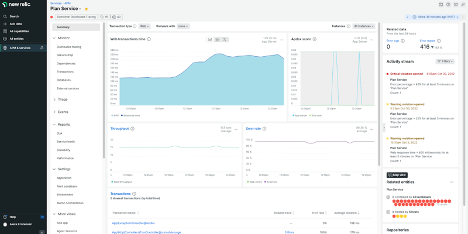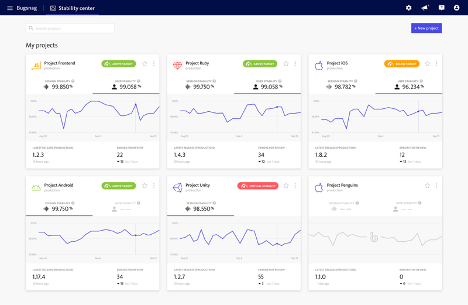APM vs. DEM: What’s the Difference?
User experience (UX) is more than a buzzword. With so much competition for attention and market share, businesses must ensure their digital products provide a seamless and intuitive experience. A good user experience can increase engagement, customer loyalty, and conversion rates, but a bad one can lead to frustration and customer churn.
As software organizations transition to Agile development methodologies, prioritizing customer feedback and collaboration over rigid development processes, they need real-time monitoring tools that better reflect user priorities rather than faceless technical metrics.
This article will examine how Application Performance Monitoring (APM) is evolving into Digital Experience Monitoring (DEM), what it means for software businesses, and how to pick the right tools.
What is APM?
Gartner defines APM as: “A suite of monitoring software comprising digital experience monitoring (DEM), application discovery, tracing and diagnostics, and purpose-built artificial intelligence for IT operations.”
In other words, Application Performance Monitoring (APM) solutions monitor the performance and stability of a software application. For example, they might look at response times or memory usage and alert DevOps personnel when there’s a problem. In addition, they typically provide diagnostics and code-level traceability to resolve the issue.

For example, if an e-commerce website has a slow response time, an APM solution would send an alert to the DevOps team. Using the APM solution, the team may discover that the latency came from a slow third-party payment gateway. The team could then work with the payment gateway to resolve the issue by providing specific diagnostics.
In addition to real-time monitoring and alerts, APMs typically offer advanced analytics and reporting. As a result, team leaders can quickly assess an application’s performance over time, identify trends, and make data-driven decisions. For instance, they may switch payment gateways to allocate time optimizing a specific part of the app.
From APM to DEM
Gartner defines DEM as: “An availability and performance monitoring discipline that supports the optimization of the operational experience and behavior of a digital agent, human or machine, as it interacts with enterprise applications and services.”
Digital Experience Monitoring (DEM) quantifies and measures the end user’s experience while expanding visibility. Rather than looking at a single application, these tools offer insights into the business impact of technical problems and enable organizations to diagnose and fix business problems that occur across multiple applications (e.g., microservices).
Using the same e-commerce example, a DEM might find that only a handful of errors occur on the wishlist page. While an APM solution may ignore these errors given their minimal technical impact, a DEM may flag that VIP users frequently use wish lists, and the business costs of these errors are much higher.
Or, a DEM might notice that users interacting with a page containing third-party APIs are experiencing errors. While the e-commerce application doesn’t cause these errors, it damages the user experience. These may not have been flagged by an APM solution focused on more application-specific monitoring.
Notably, DEM solutions offer the same technical diagnostic functionality as APM solutions. But they can also troubleshoot broader business-level problems that aren’t as obvious with APM solutions. And at the same time, they shift the focus away from an application to a customer, helping prioritize problems when they arise.
Key Differences
Make the Leap with BugSnag
BugSnag makes it easy to implement Digital Experience Monitoring with libraries for over 50 platforms and integrations with the most popular development tools. With a few lines of code, you can instantly start monitoring real users and route any errors to your existing team communication or bug-tracking apps for follow-up.

Several features set BugSnag apart from other DEMs:
- Prioritization – BugSnag automatically prioritizes bugs based on their impact on actual users. That way, you can fix what matters without wasting time on what doesn’t. Doing this can save your team time and help you maximize productivity.
- Intelligent Routing – BugSnag’s Bookmarks make it easy for specific team members to opt-in to receive alerts about bugs that matter to them. As a result, it’s much easier to foster code ownership and avoid notification fatigue.
- Stability Scores – BugSnag’s Stability Scores provide a single metric to help product managers make a go/no-go decision for each release by ensuring it meets a certain error rate threshold. And, you can focus on bugs only when it’s necessary.
Getting started with Bugsnag is also incredibly easy. After installing an error reporting library, you simply initialize the library in your application, and it will start recording any errors. Then, you can access and configure the errors to route to relevant teams in Bugnsag’s dashboard. And finally, you can integrate with your existing tools to minimize workflow disruptions.
If you’re looking for a more comprehensive Digital Experience Monitoring solution, start a free trial or request a demo to see how you can improve quality and deliver a robust user experience.
The Bottom Line
Application Performance Monitoring (APM) solutions have helped software businesses detect errors for years. But more recently, Digital Experience Monitoring (DEM) has helped refocus performance issues on real user experiences rather than application metrics. As a result, teams can more effectively prioritize work and ensure a robust UX.